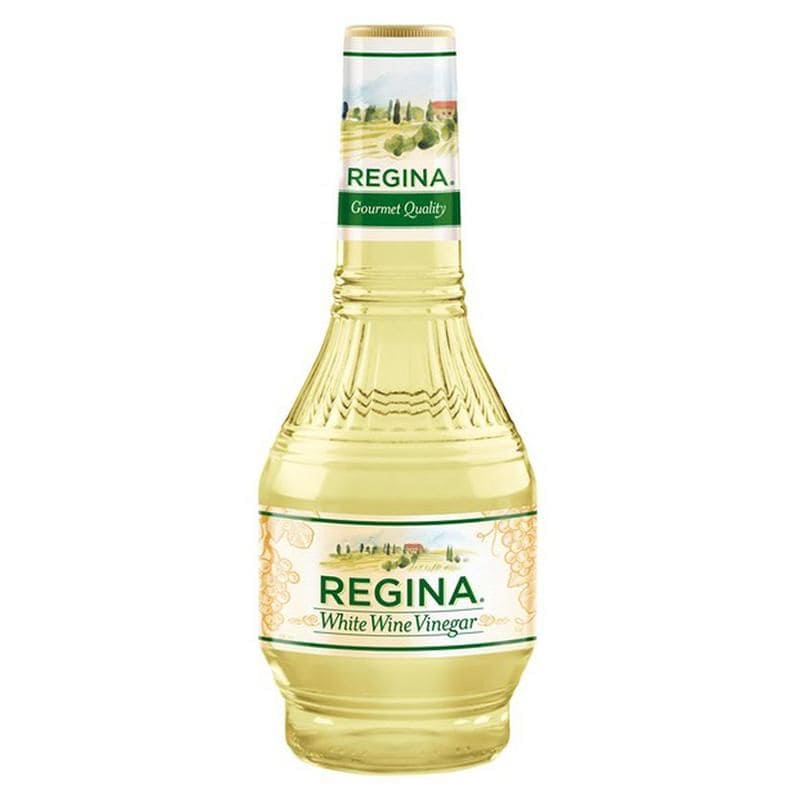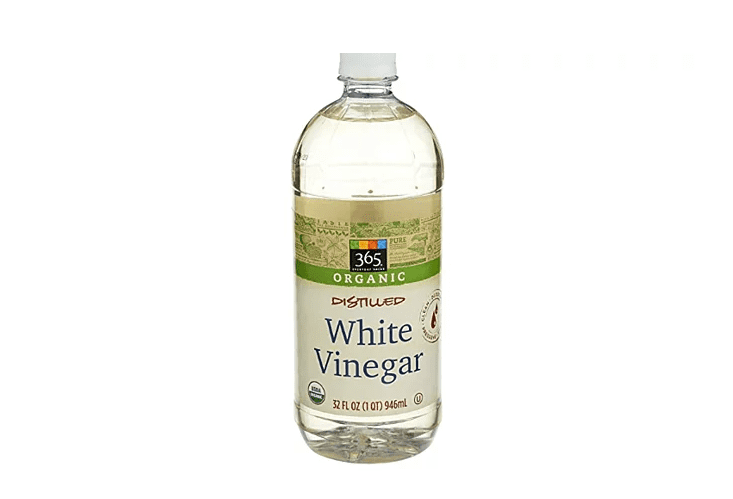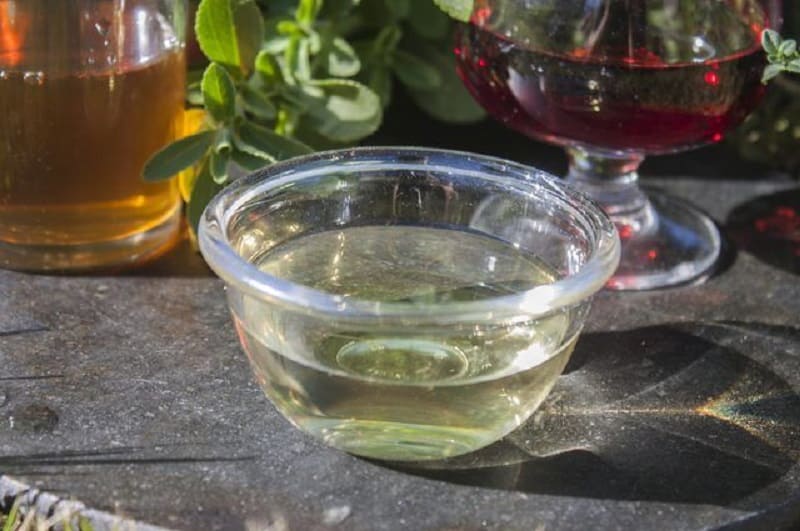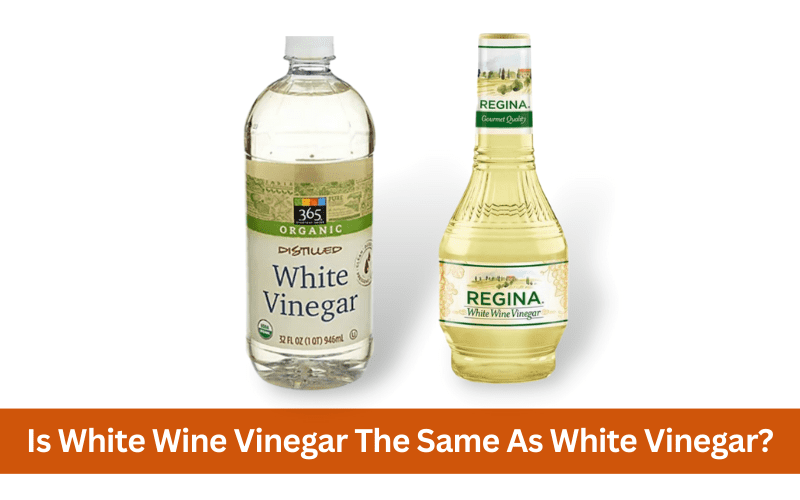Have you ever been in the middle of making a salad dressing or pickling some vegetables and found yourself wondering, is white wine vinegar the same as white vinegar? “No, they are different” is the answer. I’ve always been curious as to whether or not these two vinegars can be used interchangeably, or whether each has unique characteristics that make it more suited to certain dishes. In this article, we’ll explore is white wine vinegar the same as white vinegar, and help you decide which one to use in your next recipe.
Is White Vinegar and White Wine Vinegar the same?
Is white wine vinegar the same as white vinegar? No, white wine vinegar is not the same as white vinegar. While both types of vinegar are made through a similar fermentation process, they are made from different starting materials and have distinct flavors and characteristics.
White wine vinegar is made from white wine and has a more subtle, fruity flavor, while white vinegar is made from diluted grain alcohol and has a sharp, acidic taste.
The two vinegars are not interchangeable in recipes, and it’s important to use the correct vinegar for the desired flavor and acidity.
What is White Wine Vinegar?
White wine vinegar is a type of vinegar that is made from white wine. It has a pale yellow color and a tangy, acidic flavor with a subtle fruitiness. It is commonly used in cooking and salad dressings.
How is white wine vinegar made?
White wine vinegar is typically made through a two-step fermentation process. Here are the basic steps involved in making white wine vinegar:
- First, white wine is made from grapes or grape juice.
- The wine is then exposed to acetobacter bacteria, which convert the alcohol in the wine into acetic acid through a process called oxidation.
- The resulting mixture is left to ferment for several months to a year, during which time the acetic acid levels increase and the flavor and aroma of the vinegar develop.
- Once the desired flavor and acidity levels are reached, the vinegar is filtered, bottled, and ready to use.
Benefits of white wine vinegar
White wine vinegar offers several potential benefits, both for culinary purposes and for health:
- Enhanced flavor: White wine vinegar adds a tangy, acidic flavor to dishes and can help enhance the taste of other ingredients.
- Low calorie: White wine vinegar has a low calorie count, making it a good option for those watching their calorie intake.
- Potential health benefits: Some research suggests that white wine vinegar may have antimicrobial and antioxidant properties, and could potentially offer health benefits such as lower blood sugar and cholesterol levels, although more research is needed in these areas.
- Versatile: White wine vinegar can be used in a variety of recipes, from salad dressings to marinades to sauces, and is a staple in many kitchens.
Varieties of white wine vinegar
There are several varieties of white wine vinegar, each with its own unique flavor and characteristics. Here are some of the most common types:
- Champagne vinegar: Made from champagne, this type of white wine vinegar has a light, delicate flavor and is often used in vinaigrettes and sauces.
- Rice wine vinegar: Made from fermented rice, this vinegar has a mild, slightly sweet flavor and is commonly used in Asian cuisine.
- Sherry vinegar: Made from sherry wine, this vinegar has a complex flavor with notes of nuttiness and sweetness. It’s often used in Spanish and Mediterranean dishes.
- White balsamic vinegar: This vinegar is made from white grape must, and has a sweeter, less acidic flavor than traditional white wine vinegar. It’s often used in lighter dishes and dressings.
These are just a few examples of the many varieties of white wine vinegar available, each with its own distinct flavor profile and best uses in cooking.

What is White Vinegar?
White vinegar is a type of vinegar that is made from diluted grain alcohol. It is clear and colorless, with a very sharp, acidic taste and pungent aroma. White vinegar is commonly used in cooking, baking, and cleaning due to its strong acidic properties. It is also a popular ingredient in pickling recipes.
How is white vinegar made?
White vinegar is made by fermenting grain alcohol with acetic acid bacteria. Here are the basic steps involved in making white vinegar:
- First, grain alcohol (usually made from corn or wheat) is diluted with water to a specific acidity level.
- Next, the diluted alcohol is placed in large tanks and inoculated with a “mother” culture of acetic acid bacteria. The bacteria consume the alcohol and convert it into acetic acid through a process called oxidation.
- The mixture is left to ferment for several weeks to several months, during which time the acetic acid levels increase and the flavor and aroma of the vinegar develop.
- Once the desired acidity and flavor are reached, the vinegar is filtered, bottled, and ready to use.
The specific process and ingredients used can vary depending on the manufacturer, but the basic principles of fermentation and oxidation are the same.
Benefits of white vinegar
White vinegar has several benefits that make it a useful ingredient in cooking, cleaning, and more. Here are some of the most notable benefits:
- Cleaning: White vinegar is a powerful cleaning agent due to its high acidity level, which makes it effective at dissolving dirt, grease, and grime. It can be used to clean surfaces, floors, appliances, and more.
- Preserving: White vinegar is commonly used in pickling and preserving due to its ability to inhibit the growth of bacteria and other microorganisms.
- Cooking: White vinegar can be used in cooking and baking to add acidity and flavor to dishes. It’s often used in marinades, dressings, and sauces.
- Weed killer: White vinegar can be used as a natural and non-toxic weed killer by spraying it directly on unwanted plants.
- Health benefits: Some research suggests that white vinegar may have potential health benefits, such as improving blood sugar control and aiding in weight loss, although more research is needed in these areas.
Varieties of white vinegar
There are several different varieties of white vinegar, each with its own unique characteristics and uses. Here are some of the most common types:
- Distilled white vinegar: This is the most common type of white vinegar, made from grain alcohol that has been distilled to increase its purity. It has a very sharp, acidic taste and is often used for cleaning and pickling.
- Cleaning vinegar: This is a stronger version of distilled white vinegar, with an acidity level of around 6%. It’s specifically designed for cleaning and can be used to clean surfaces, floors, and appliances.
- Pickling vinegar: This type of vinegar is specially formulated for use in pickling recipes. It has a slightly lower acidity level than distilled white vinegar, typically around 5%, and may include other ingredients like salt and spices.
Overall, distilled white vinegar is the most versatile and commonly used type of white vinegar, but cleaning and pickling vinegars can be useful for specific purposes.

Do These Two Kinds of Vinegar Look Similar?
Both white wine vinegar and white vinegar are clear and colorless, so they can look similar at first glance.
However, white wine vinegar may have a slightly yellowish or golden hue due to its fermentation process with white wine. White vinegar, on the other hand, is typically completely clear.
Do White Wine Vinegar and White Vinegar Taste the Same?
No, white wine vinegar and white vinegar do not taste the same. White wine vinegar has a milder, fruitier taste than white vinegar, which has a sharper, more acidic taste and pungent aroma.
The flavor of white wine vinegar is also influenced by the type of white wine used in the fermentation process, which can impart different flavor notes such as fruitiness or oakiness. In contrast, white vinegar is made from grain alcohol and has a much stronger, more pungent taste.
So while both vinegars may be used for similar purposes in cooking and cleaning, they have distinct flavor profiles that can make a significant difference in the taste of a recipe.
Do White Wine Vinegar and White Vinegar Smell the Same?
No, white wine vinegar and white vinegar do not smell the same. White wine vinegar has a milder aroma than white vinegar, with fruity and floral notes that can vary depending on the type of white wine used in the fermentation process. White vinegar, on the other hand, has a strong, pungent aroma that can be overpowering if used in large amounts.
What are White Wine Vinegar and White Vinegar Used for?
Both white wine vinegar and white vinegar are versatile ingredients that can be used in a variety of ways in cooking and cleaning. Here are some of the most common uses for each:
White wine vinegar
- Adding acidity and flavor to salad dressings and marinades
- Balancing sweetness in sauces and glazes
- Tenderizing meats and seafood
- Deglazing pans to create flavorful sauces
- Pickling vegetables and fruits
- Cleaning fruits and vegetables to remove pesticides and bacteria
- Removing stains from clothes and linens
White vinegar
- Cleaning surfaces, floors, and appliances
- Removing stains and odors from clothes and linens
- Disinfecting cutting boards and other kitchen tools
- Removing mineral buildup from coffee makers and other appliances
- Pickling vegetables and fruits
- Tenderizing meats and seafood
- Keeping flowers fresh by adding to vase water
In short, white wine vinegar is primarily used in cooking and adding flavor to dishes, while white vinegar is mostly used for cleaning and pickling, although they do have some overlap in their uses.
What is the Difference Between White Wine Vinegar and White Vinegar? – Chart
Now you know is white wine vinegar the same as white vinegar, so it’s time to take a look at the different chart between the two kinds of vinegars.
| White Wine Vinegar | White Vinegar | |
| Source Material | White wine | Grain alcohol |
| Color | Pale yellow | Clear |
| Flavor | Mild, fruity, tangy | Strong, sharp, acidic |
| Aroma | Mild, fruity, floral | Strong, pungent |
| Acidity | Typically 5-7% | Typically 5-8% |
| Best Uses | Salad dressings, marinades, sauces, pickling | Cleaning, disinfecting, pickling, tenderizing |
| Shelf Life | 2-3 years | 5+ years |
| Storage | Cool, dark place | Cool, dark place |
| Health Benefits | May offer some antimicrobial and antioxidant benefits | May offer some health benefits such as improved blood sugar control and weight loss |
Can You Substitute White Wine Vinegar for White Vinegar?
Yes, you can substitute white wine vinegar for white vinegar in most recipes, although the flavor and acidity levels may be slightly different.
White wine vinegar has a milder, fruitier taste than white vinegar, so using it as a substitute may result in a slightly different flavor profile in the finished dish.
However, in many cases, the difference will be minimal and may not be noticeable. It’s important to keep in mind that white wine vinegar may be slightly more expensive than white vinegar, so substituting may be a more expensive option.

How to Store White Wine Vinegar and White Vinegar
Proper storage of white wine vinegar and white vinegar can help maintain their quality and flavor over time. Here’s how to store them:
- Keep them in a cool, dark place: Both white wine vinegar and white vinegar should be stored in a cool, dark place, away from direct sunlight and heat sources. A pantry or cupboard is a good choice.
- Keep the containers tightly sealed: Make sure the lids of the vinegar bottles are tightly sealed to prevent air and moisture from getting in. Exposure to air and moisture can affect the flavor and quality of the vinegar over time.
- Avoid storing near strong odors: Vinegar can absorb odors from other foods, so it’s best to avoid storing it near strong-smelling ingredients like garlic, onions, or spices.
- Check the expiration date: Vinegar does not spoil, but it can lose flavor and acidity over time. Check the expiration date on the bottle and try to use the vinegar before that date.
Following these simple storage guidelines can help ensure that your white wine vinegar and white vinegar stay fresh and flavorful for as long as possible.
White Wine Vinegar and White Vinegar Vs. Other Vinegars
White wine vinegar and white vinegar are just two examples of the many types of vinegar available. Here’s how they compare to some other common vinegars:
Is rice vinegar the same as white vinegar?
No, rice vinegar is not the same as white vinegar. Rice vinegar is made from fermented rice and has a mild, slightly sweet taste, while white vinegar is made from grain alcohol and has a strong, sharp taste.
Is white wine vinegar the same as white balsamic vinegar?
No, white wine vinegar is not the same as white balsamic vinegar. White wine vinegar is made from white wine and has a mild, fruity flavor, while white balsamic vinegar is made from white grape must and has a sweeter, less acidic flavor than traditional balsamic vinegar.
Is white balsamic vinegar the same as white vinegar?
No, white balsamic vinegar is not the same as white vinegar. White balsamic vinegar is made from white grape must and has a sweeter, less acidic flavor than white vinegar, which is made from grain alcohol and has a very sharp, acidic taste.
Is champagne vinegar the same as white wine vinegar?
Vinegar made from champagne is not the same as vinegar made from white wine. White wine vinegar has a moderate, fruity flavor, whereas champagne vinegar has a light, delicate flavor since it is created from champagne.
Is white wine vinegar the same as apple cider vinegar?
No, white wine vinegar is not the same as apple cider vinegar. Apple cider vinegar has a milder, sweeter, and tangier flavor than white wine vinegar, which is derived from fermented apples.
Is white modena vinegar the same as white wine vinegar?
No, white modena vinegar and white wine vinegar are not the same. White modena vinegar, also known as white balsamic vinegar, is made from white grape must and has a sweeter, milder flavor than traditional balsamic vinegar. It’s often used in light-colored dishes and dressings. White wine vinegar, on the other hand, is made from white wine and has a milder and fruitier taste.
FAQs
What vinegar is closest to white wine vinegar?
White balsamic vinegar is the vinegar that is closest in taste to white wine vinegar. It has a similar light and fruity flavor, but is made from white grapes instead of white wine.
Can I make white wine vinegar?
Yes, you can make white wine vinegar by fermenting white wine with acetic acid bacteria. The process involves allowing the wine to turn to vinegar over several weeks to several months, depending on the desired level of acidity and flavor.
How long does white wine vinegar last after being opened?
White wine vinegar can last for several years after being opened if stored properly in a cool, dark place with the lid tightly sealed. However, its flavor and acidity may diminish over time, so it’s best to use it within a year of opening for the best results.
Is white wine vinegar stronger than apple cider vinegar?
The strength of vinegar is determined by its acidity level, which is typically expressed as a percentage of acetic acid. White wine vinegar and apple cider vinegar can have similar acidity levels, typically ranging from 5% to 7%, so they are considered to be about the same strength.
Can I drink white vinegar?
While white vinegar is safe to consume in small amounts as an ingredient in food, it is not recommended to drink it straight or in large quantities as it can cause irritation to the mouth, throat, and stomach.
Can vinegar go bad?
Vinegar does not spoil, but its flavor and acidity can diminish over time, particularly if it is not stored properly. Vinegar that has been stored for a long time may have a weaker flavor and lower acidity.
Is white wine vinegar gluten-free?
Yes, white wine vinegar is generally considered to be gluten-free, as it is made from fermented white wine and does not contain any gluten-containing grains. However, some brands may add other ingredients that contain gluten, so it’s always best to check the label or contact the manufacturer to be sure.
Can white vinegar kill bacteria?
Yes, white vinegar can be an effective natural disinfectant due to its high acidity level. It can help kill bacteria, viruses, and other microorganisms on surfaces and in the air.
Is white vinegar safe for pets?
White vinegar is generally considered safe for pets, but it should be used with caution as it can be irritating to their eyes and skin. It’s best to dilute it with water before using it on pet fur or bedding.
Is white vinegar safe to use as a disinfectant?
Yes, white vinegar can be used as a natural disinfectant in the home, as its high acidity level can help kill bacteria and other microorganisms on surfaces. However, it may not be as effective as commercial disinfectants and should be used with caution on delicate surfaces.
Conclusion
In conclusion, after delving deep into the world of is white wine vinegar the same as white vinegar, it is safe to say that white wine vinegar and white vinegar are not the same. Although they may look alike and have similar uses, they have differences in taste, aroma, ingredients, and uses. I have found that white wine vinegar adds a more complex flavor to salads and sauces, while white vinegar is more suitable for cleaning and pickling. However, both are versatile ingredients that have their own unique benefits in cooking and beyond. So, when picking out vinegar at the store, remember to pick the best one for the job at hand.
I’m Chen Mina, from Vol de Nuit, who has a special passion for bartending, especially mixing wine, beer, and cooktail. Here you will find content about alcoholic beverages, I will bring you knowledge that few people know about this drink.





